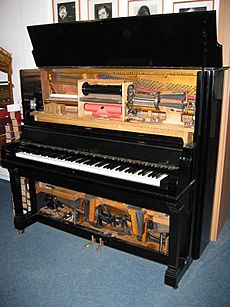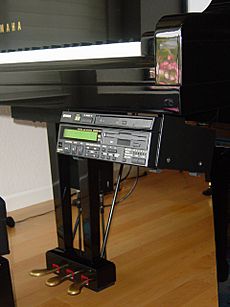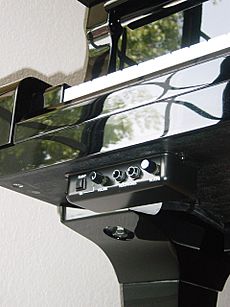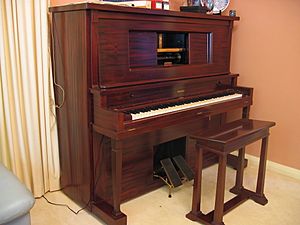Player piano facts for kids
A player piano (also called a pianola) is a special piano that can play itself! It has a clever system, either using air (pneumatic) or electricity and mechanics, that makes the piano keys move. This system plays music that is stored on special perforated paper rolls. Newer player pianos use digital files, like MIDI, to play music.
Player pianos became very popular in homes in the late 1800s and early 1900s. Their sales reached their highest point in 1924. However, their popularity dropped as record players got better and radio became common. The stock market crash of 1929 also greatly reduced their production.
Contents
History of Player Pianos
Player pianos have a fascinating history, starting with early inventions and evolving over time.
Early Inventions and Growth
In 1896, Edwin S. Votey created the first practical player piano system. He called it the Pianola. This system used air pressure to work. Foot pedals powered bellows, which created a vacuum. When holes in the paper roll passed over a special bar, air rushed in. This air movement was amplified to make the piano keys strike notes.
Votey advertised the Pianola widely, using large, colorful ads. It first sold for about $250. Soon, other companies made cheaper versions. An early standard used 65 notes and 11.25-inch wide rolls. However, many companies had their own roll sizes, which meant rolls from one brand might not work on another.
By 1903, the Aeolian Company had over 9,000 song titles in their catalog. They added 200 new songs every month! Most of these were light, religious, or classical music. Ragtime music was also available, but less common.
Melville Clark later improved player pianos. He introduced rolls that could play all 88 notes of a piano keyboard. He also made the player mechanism built right inside the piano, rather than being a separate attachment.
Standardizing Music Rolls
By the end of the 1900s, the older 65-note system became outdated. This caused problems for smaller manufacturers. In 1908, piano makers met in Buffalo, New York. They agreed on a new standard for music rolls. This new "Buffalo Convention" standard used 88 notes. The rolls were still 11.25 inches wide, but the holes were smaller and closer together. This agreement was very important. It stopped a "format war" where different rolls wouldn't work on different pianos.
Reproducing Pianos Emerge
While player pianos were growing in America, Edwin Welte in Germany created something new. In 1904, he launched the Welte-Mignon. This was a "reproducing piano." It could play back a recorded performance exactly as the original pianist played it. This meant famous pianists could record their music on special rolls. Then, owners of these pianos could hear the exact performance in their own homes!
Other companies soon made their own reproducing pianos. These included the Ampico (from 1911) and the Duo-Art (1914) in America. These instruments were more expensive. It's thought that only about 5% of all player pianos sold were reproducing pianos.
New Roll Types and Decline
Two big advances in music rolls were "hand-played rolls" and "word rolls."
- Hand-played rolls included musical phrasing. This meant the player piano could play with more expression. Owners didn't have to use the tempo controls as much.
- Word rolls had song lyrics printed on the side. This made it easy for people to sing along at home. Singing around the piano was very popular before radio and records became common.
By the 1920s, the "jazz age" made the player piano popular for dance music. Most American companies stopped offering large classical music catalogs. In England, however, classical music rolls remained popular. People there also enjoyed using the controls to add their own expression to the music.
Revival and Modern Times
In the 1950s, people started collecting old player pianos. Frank Holland in England formed 'The Player Piano Group' in 1959. He later started the Musical Museum in London. In America, Harvey Roehl wrote a popular book called Player Piano Treasury in 1961. This book helped many people learn about and restore these instruments.
The renewed interest in the 1960s led to new player pianos being made. Companies like Aeolian brought back the Pianola. QRS Music, a company that made music rolls, continued to produce new rolls. This meant that player pianos could still play the latest songs.
Today, many original player pianos from the 1920s still work. People continue to restore and enjoy these amazing instruments.
Types of Player Pianos
There are different kinds of player pianos, each with unique features. All player pianos have a mechanism that plays the keys using air pressure. The person operating it can usually control some parts of the performance.
Manually Controlled Players
These are the most common player pianos. The operator uses levers to change the music.
- Split stack control: Most player pianos have their playing mechanism divided into two halves. This lets the operator change the volume of the bass (left) or treble (right) side of the keyboard separately. This creates musical effects.
- Theme control: These pianos have special systems that can make the melody notes louder than the background music. Special music rolls are used with these systems. Some systems, like Aeolian's "Themodist," allowed for more control over how loud the melody and background were.
- Isolated theme: These pianos could pick out the melody notes from the background music across the entire keyboard. They did not need special ways of punching holes in the music roll to do this. Examples include the UK "Dalian" and "Kastonome."
- Expression player: These pianos could create a general musical feeling (dynamics) from codes on the music roll. The air pressure system would change to preset levels based on the roll's coding. This gave a sense of musical expression.
Reproducing Pianos

Reproducing pianos are fully automated. They don't need a person to control them to sound like a live performance. This is because the music rolls for these pianos capture the exact timing and volume of a live performance. An electric motor usually powers them, so no foot pedaling is needed. Many reproducing pianos can also be played manually, like regular player pianos. The first successful one was the "Mignon" by Welte in 1904.
Music Rolls
Music rolls are long sheets of paper that store the music for player pianos. They are rolled onto a spool. The spool fits into a special box on the player piano. The end of the paper sheet is then attached to a "take-up spool." This spool unwinds the roll at a steady speed over a "tracker bar." The music is programmed onto the paper using small holes, called perforations. Different player systems might have different hole sizes or layouts, but most follow a few main standards.
Music is put onto these rolls in several ways:
- The music is marked directly from sheet music onto a master stencil. The player then creates their own musical performance.
- A special machine with a piano keyboard is used to punch the holes.
- A live performance is played on a special piano connected to a marking machine. This creates a stencil from the live playing.
- Today, computer software and MIDI can create piano roll stencils. These can be used to make new rolls.
Player pianos were sold all over the world. Music rolls were made in many countries, including the US, Europe, South America, Australia, and New Zealand. Many old rolls still exist today and are often found by collectors.
QRS Music is currently the only company that still mass-produces piano rolls. They claim to have 45,000 titles available and add new ones regularly. The Musical Museum in London has a huge collection of over 20,000 piano rolls.
Modern Player Pianos


Modern player pianos have advanced greatly. They no longer use paper rolls. Instead, they use magnetic tape, floppy disks, or even computers to store and play music.
In 1982, Yamaha Corporation introduced the "Piano Player." This was the first widely available player piano that could record and play back piano performances digitally. It used floppy disks to store the music. Later models, like the Disklavier PRO, can record very detailed performances. They capture many levels of how hard a key is pressed and how far the pedals are used.
Most modern player pianos use MIDI. MIDI allows them to connect with computers. These pianos often have a device that can play MIDI files from floppy disks or CD-ROMs. They also have a MIDI interface to connect directly to computers. MIDI files can control small electromechanical solenoids inside the piano. These solenoids use electricity to move the keys and hammers. This means live performances or computer-made music can be played back exactly. You can even buy MIDI files of old piano rolls online.
Many kits are available today (like PianoDisc and PNOmation). These kits can turn a regular piano into a computer-controlled instrument. This usually involves adding mechanical parts under the keyboard.
Steinway now makes a player piano called Spirio. It uses a system developed by Wayne Stahnke. In 2019, Steinway introduced the Spirio | r. This model can both play back and record piano music.
Another company, Edelweiss Pianos, makes custom player pianos. They are known for their luxury designs.
Player Pianos vs. Electric Pianos
It's important to know that a player piano is different from an electric piano, electronic piano, or digital piano.
A player piano is an acoustic piano. This means its sound comes from hammers hitting real piano strings. The electrical parts in a player piano only move the keys or hammers. They copy what a person's fingers would do. They do not create sound using electricity or speakers.
Electric, electronic, and digital pianos, on the other hand, create their sound using electronic circuits or digital samples. They usually need to be plugged into an amplifier or headphones to be heard.
See also
 In Spanish: Pianola para niños
In Spanish: Pianola para niños
- Mechanical organ
- Punched tape
- Virtual piano
- Circus Galop, a piano piece specifically designed for the player piano
- Conlon Nancarrow, a significant composer for the player piano
Images for kids





